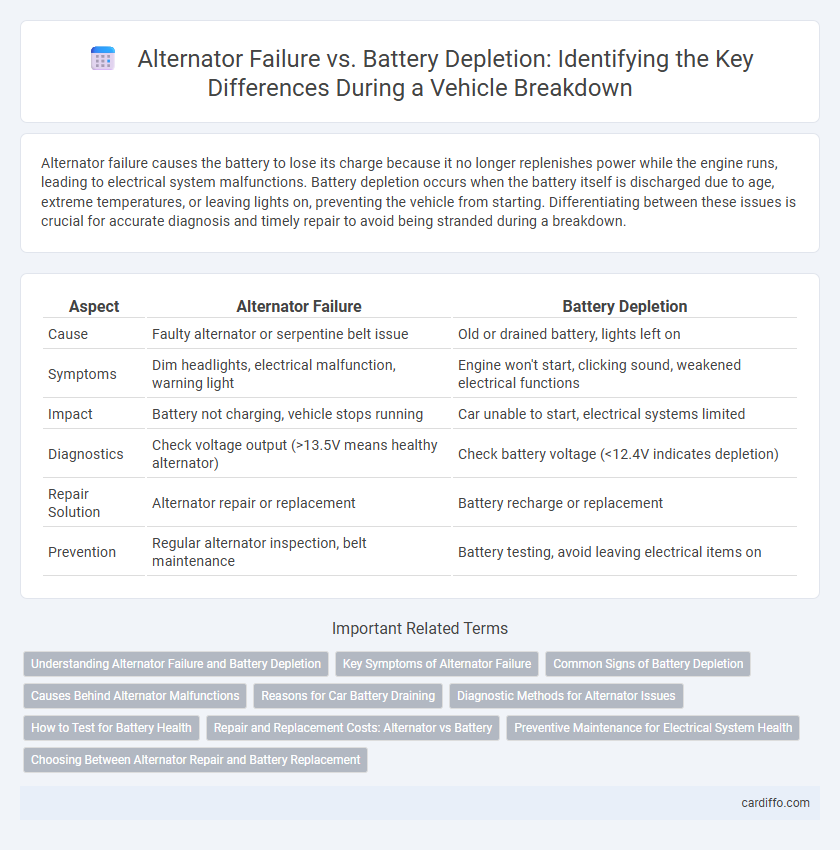Alternator failure causes the battery to lose its charge because it no longer replenishes power while the engine runs, leading to electrical system malfunctions. Battery depletion occurs when the battery itself is discharged due to age, extreme temperatures, or leaving lights on, preventing the vehicle from starting. Differentiating between these issues is crucial for accurate diagnosis and timely repair to avoid being stranded during a breakdown.
Table of Comparison
| Aspect | Alternator Failure | Battery Depletion |
|---|---|---|
| Cause | Faulty alternator or serpentine belt issue | Old or drained battery, lights left on |
| Symptoms | Dim headlights, electrical malfunction, warning light | Engine won't start, clicking sound, weakened electrical functions |
| Impact | Battery not charging, vehicle stops running | Car unable to start, electrical systems limited |
| Diagnostics | Check voltage output (>13.5V means healthy alternator) | Check battery voltage (<12.4V indicates depletion) |
| Repair Solution | Alternator repair or replacement | Battery recharge or replacement |
| Prevention | Regular alternator inspection, belt maintenance | Battery testing, avoid leaving electrical items on |
Understanding Alternator Failure and Battery Depletion
Alternator failure occurs when the alternator is unable to recharge the battery, causing electrical components to malfunction and the battery to drain rapidly. Battery depletion happens when the battery loses its charge due to age, parasitic drains, or insufficient charging, leading to the vehicle failing to start. Diagnosing alternator failure involves testing voltage output, while battery depletion requires checking battery health and charge levels.
Key Symptoms of Alternator Failure
Key symptoms of alternator failure include dimming or flickering headlights, a dead battery despite recent charging, and warning lights such as the battery or alternator indicator on the dashboard. Unusual noises like grinding or whining from the alternator area often signal internal component wear or bearing failure. Frequent stalling, electrical issues with accessories, and difficulty starting the vehicle also point to alternator malfunction rather than simple battery depletion.
Common Signs of Battery Depletion
Dim headlights, slow engine crank, and dashboard warning lights are common signs of battery depletion rather than alternator failure. A battery that frequently needs jump-starting or shows corrosion on terminals typically indicates depletion. Unlike alternator failure, battery depletion primarily affects starting power without causing dimming lights during engine operation.
Causes Behind Alternator Malfunctions
Alternator malfunctions primarily stem from worn-out bearings, damaged voltage regulators, and faulty diodes that disrupt electrical flow and battery charging. Heat damage and contaminated or loose belts also contribute to alternator failure by impairing its mechanical operation. These issues prevent the alternator from generating sufficient current, leading to battery depletion despite a functional battery.
Reasons for Car Battery Draining
Car battery draining often results from alternator failure, where the alternator cannot sufficiently recharge the battery while the engine runs. Faulty alternator diodes or a worn-out voltage regulator lead to inadequate electrical output, causing the battery to lose power rapidly. Additionally, parasitic drains from electrical components such as interior lights, infotainment systems, or faulty wiring increase battery depletion symptoms.
Diagnostic Methods for Alternator Issues
Diagnostic methods for alternator issues include using a multimeter to measure voltage output, with readings below 13.5 volts indicating potential failure. Further testing involves checking the drive belt tension and inspecting for worn brushes or faulty diodes within the alternator. Advanced diagnostics may incorporate an oscilloscope to analyze the alternator's waveform for irregularities signaling component degradation.
How to Test for Battery Health
Test battery health by measuring the voltage with a multimeter; a fully charged battery should read around 12.6 volts or higher when the vehicle is off. Perform a load test using a battery load tester to assess how the battery performs under stress, with acceptable voltage remaining above 9.6 volts during the test. Check for signs of corrosion on terminals and ensure cables are tightly connected, as poor contacts can mimic battery depletion symptoms despite a functional alternator.
Repair and Replacement Costs: Alternator vs Battery
Alternator repair or replacement typically costs between $300 and $700, while battery replacement ranges from $100 to $250 depending on battery type and vehicle model. Alternator failure often leads to additional electrical system issues, increasing repair expenses beyond the initial alternator costs. Battery depletion is usually less expensive to fix but may require repeated replacements if underlying charging problems persist, highlighting the importance of accurately diagnosing the source of the breakdown.
Preventive Maintenance for Electrical System Health
Alternator failure often causes electrical system breakdowns by preventing the battery from charging, leading to complete power loss. Battery depletion typically results from prolonged use without recharging or parasitic drain, causing the vehicle to fail starting. Preventive maintenance, including regular alternator testing and battery checks, ensures early detection of faults, preserving electrical system health and preventing unexpected breakdowns.
Choosing Between Alternator Repair and Battery Replacement
Alternator failure causes the battery to lose charge quickly, resulting in dim lights and engine stalling, while battery depletion typically shows slow starting and electrical malfunctions. Diagnosing the source requires testing the alternator's voltage output and battery capacity using a multimeter to identify the root cause accurately. Opting for alternator repair is cost-effective when the charging system is faulty, whereas battery replacement is necessary if capacity tests reveal significant battery degradation.
Alternator failure vs battery depletion Infographic

 cardiffo.com
cardiffo.com